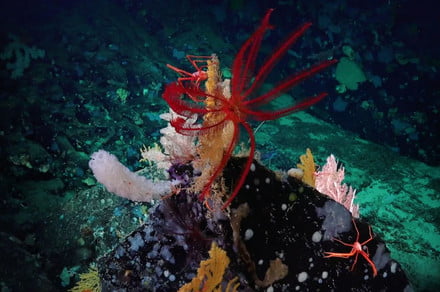The deep sea is a strange and scary place, being one of the last great unexplored habitats on our planet. But technology is developing that lets us glimpse the bottom of the ocean and even listen to its sounds. Now a team from the Schmidt Ocean Institute in Palo Alto, California, have shared remarkable images from their expeditions to the depths.
At least four new species of deep-sea corals and six other animals that are new to science were found on this expedition. Schmidt Ocean Institute
The research vessel Falkor was sent out off the coast of Costa Rica to collect information about deep sea ecosystems, looking in particular at natural gas seeps and other areas which host specialized biological communities. The team look at life of all sizes, from tiny microbes to full sized fish and corals, and found a delicate balance between creatures of all kinds. They found at least four new species of deep-sea corals, as well as new animals that scientists had not observed before.
And best of all, they took amazing photos.
This black coral is at least 2 meters tall, leading researchers to estimate its age to be around 1,000 years old. Schmidt Ocean Institute
The team hopes that the results of their survey of the corals and the complex communities that they play host to can be used to support the creation of a new protected marine area to keep the environments safe from fishing or mining.
“This new research will support Costa Rica’s efforts to conserve these important habitats by providing a baseline of the incredible species and ecosystems found in the deeper areas that don’t always attract the attention that they deserve,” Schmidt Ocean Institute co-founder Wendy Schmidt said in a statement. “One of the most important things we can do right now is to understand how these communities work, so, if there are changes in the future, we can measure human impact.”
Limatulidae, also know as file shells. They are able to swim and are closely related to scallops. In this picture, its valves are open. Schmidt Ocean InstituteGlyphocrangon, a kind of shrimp that is common on the seafloor. Schmidt Ocean InstituteBrittle star or ophiuroid. This one is unusual because it has very reduced arms, and you can tell that it is a female because it has eggs. Schmidt Ocean InstituteSphaerodorid polychaete, a type of bristle worm which lives in sea sediment. Schmidt Ocean Institute
The data was collected in part using SuBastian, a Remotely Operated Vehicle also called a remote controlled submarine, which is lowered from a ship and is piloted from above as it descends into the ocean.
SuBastian is lowered from the ship. Schmidt Ocean Institute
“Every dive continues to amaze us,” said Dr. Erik Cordes of Temple University, the expedition leader. “The deep sea is the largest habitat on Earth. Understanding how that habitat functions will help us to understand how the planet as a whole works.”
Editors’ Recommendations
- Only three people have explored the deep oceans. Meet the next two
- Dark matter heats up and moves around in dwarf galaxies during star formation
- Ghostly galaxy discovered lurking on the edge of the Milky Way
- Scientists find a technique to identify electricity-producing bacteria
- Water-based fuel cell converts carbon emissions to electricity

